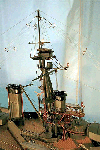 |
Reviewed by Sean Hert |
 |
On occasion, a book detailing the build of a single, and singularly, outstanding sample of the ship modeler's craft comes out. William Mowll's latest book, Thunderer: Building a Model Dreadnought is one of those books. It chronicles his 1/96 scale build of HMS Thunderer from start to finish. This 160-page book is an audit-course on large scale, static ship modelling.
Book Contents
- Acknowledgements
- Foreword
- Chapter 1: History and Background
- Chapter 2: The Building Programme
- Chapter 3: Propulsion, Decks and Funnels
- Chapter 4: Armaments and Electronics
- Chapter 5: Masts
- Chapter 6: Ship's Fittings
- Chapter 7: Nearing the End: Auxiliary Craft
- Chapter 8: HMS Thunderer, USS Texas
- Postscript
- Bibliography
- List of suppliers
After the author's Acknowledgements, there is a single page Foreword by Simon Stephens, Curator, Ship Model and Boat Collections, The National Maritime Museum, Greenwich, London. The bulk of the book is covered in 8 chapters, each with a number of sub-headings. For example, chapter 3 is broken down into three sections:
Chapter 3: Propulsion, Decks and Funnels
- Propellers
- Decks and Decking
- Fabricating Funnels
Mowll uses a number of different techniques throughout his book, some which may seem a bit antiquated or outdated, but still serve admirably. In fact, I think there is much to be learned from the skills and techniques shown here. Not to say this book is some sort of a throwback to the "old ways" of doing things, far from it. Thunderer is built using a nice mix of current shop techniques properly seasoned with some traditional methods. I found his broad use of the propane torch particularly insightful, and it will influence and change a number of my own shop practices in the future.
 |
 |
 |
 |
 |
 |
 |
 |
Following the construction of Thunderer, many of the states are documented with photos, with more covered in the text. Mowll uses both wood and metal in his HMS Thunderer, demonstrating his deft hand with both these dissimilar materials. In fact, he utilizes different types of each; different woods have different properties, appropriate to different stages in the build, just as he used different metals. White metal cast for guns, brass and aluminum sheet, copper for the hull plating; each stage has something new to show, and learn. The author does briefly touch upon lighting his model with DC lamps, as well as utilizing some R/C equipment to rotate the guns, but this is still as static model. There are some skills an R/C modeler would be sure to appreciate, but keep in mind this is not an R/C book.
This book not only covers the straight construction of the model, but also delves into some of the skills need to build the fittings. I found the sections on mold making and casting in metal very interesting, being different from the usual resin casting one sees most common today (but still using plastic building blocks for the molds!). He also shows some different machining steps, and discusses his ropewalk for making scale rope and cable for rigging- facinating stuff. The only topic that is dealt with in an almost coursour fashion is the painting of the model.
Chapter 7, covering the "Auxiliary Craft", is worthy of a book in it's own right. This varied skills and techniques used to make the floatplanes and ship's boats are a treasure- my only complaint of this book is this section is too small!
Chapter 8 covers a visit to the USS Texas outside Houston, Texas. Drawing parallels between HMS Thunderer and USS Texas helps the author feel closer to his model project, and brings it to a fitting finale. There is a short postscript from Mowll, briefly discussing the Battle of Jutland- and HMS Thunderer's role in it.
The time of dreadnoughts is not a period I normally enjoy, but this book surprised me. Thunderer: Building a Model Dreadnought is a great book, one that I found myself appreciating it more and more as I read it. It will sit with my other references, and I am sure I will pick it up again- sometimes to review a technique, and sometimes just to enjoy the ride to the completed ship at the end.
Thunderer: Building a Model Dreadnought is available direct from the publisher, Seaforth Publishing (an imprint of Pen and Sword books), Amazon.com US and UK, and the Naval Institute Press (800-233-8764). Prices vary.
 |
